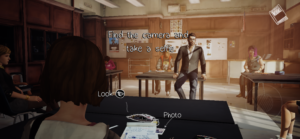Game:
Life is Strange
Creator:
Dontnod Entertainment
Platform:
iOS
Target Audience:
Likely teenagers or high schoolers since the main characters are high schoolers. However it also is likely young adults since it deals with more mature themes.
Types of Fun:
Narrative, discovery
Analysis:
The interesting mechanic behind Life is Strange (being able to time travel and repeat or explore different decisions) gives players the ability to control their loops and thus story arcs to an extent. A user can choose a loop and iterate through that loop with different decisions via the time travel mechanic. This in turn shapes the narrative arc as these loop permutations affect the story. Loops are also used more simply to help players get a grasp of the gameplay. For example, when I was at the desk, I could repeatedly look around at various items in order to get a grasp of the game mechanics. Items typically had a “look” function or a “look” and “do some action” function. This helped me get acquainted with the style of gameplay.

The contrasting scenes of light and dark throughout the narrative have a play in the storyline. It helps reflect the contrasting emotions and scenes present through the game. The architecture helps players feel the drastic changes in emotion throughout.
The story being non linear helps define the mystery and thus discoverability factor. The mechanic of giving limited choices to the user along with minimal direction helps make the narrative aspect the central focus. The mechanic of limited direction and utility creates a dynamic that makes the users feel like they are not playing “a game”. The mechanic creates less distraction for the player which in turn allows them to focus on the type of fun which is mainly narrative (and in this case, a mystery narrative). Users are essentially forced to experience the dialogue and arcs presented because of the limit in user actions. For example, interrupting the exploration of my desk with a dialogue and cut scene makes the narrative feel more immersive. One issue I found from this mechanic was that at times, there was too little direction. When navigating the journal, it was intuitive to me to swipe to navigate pages but I could not figure out how to exit or what I “should” be doing in there. I had to close the app and reopen it to get out of it. And when I was in the journal, I felt slightly overwhelmed since I did not know what to be doing. This however might be part of the intended mystery aspect. Overall though, better balancing direction and the lack there of I think would make the game better.




